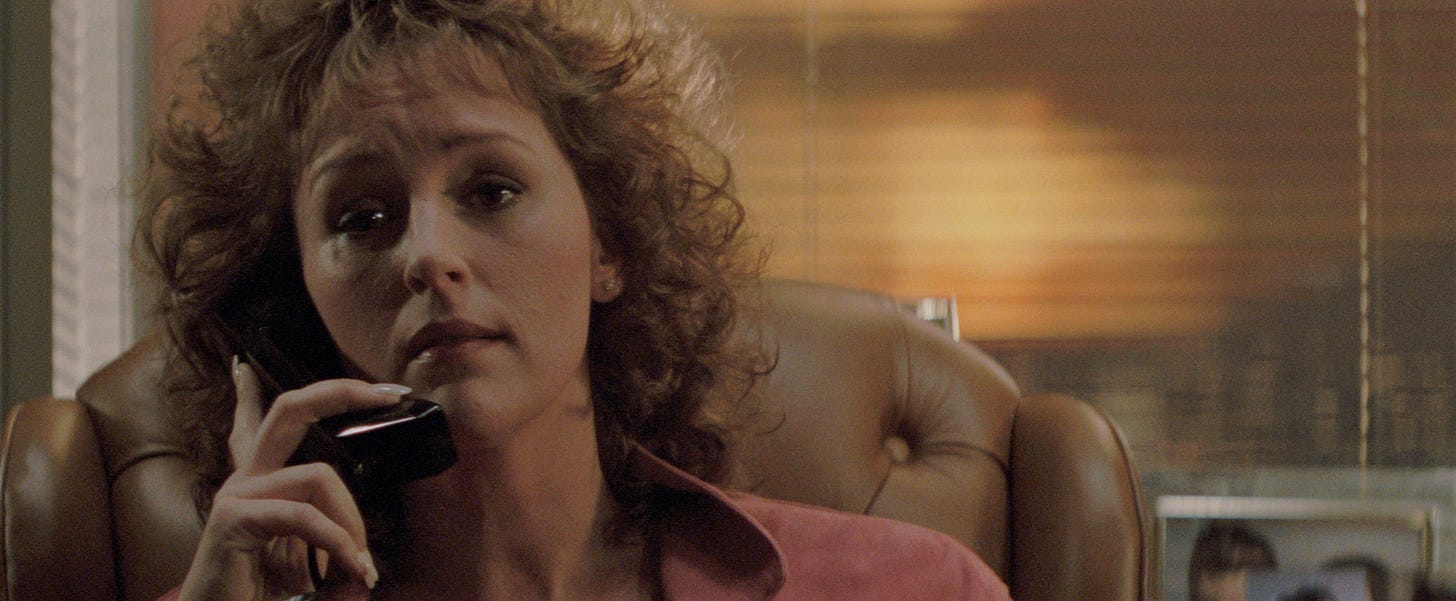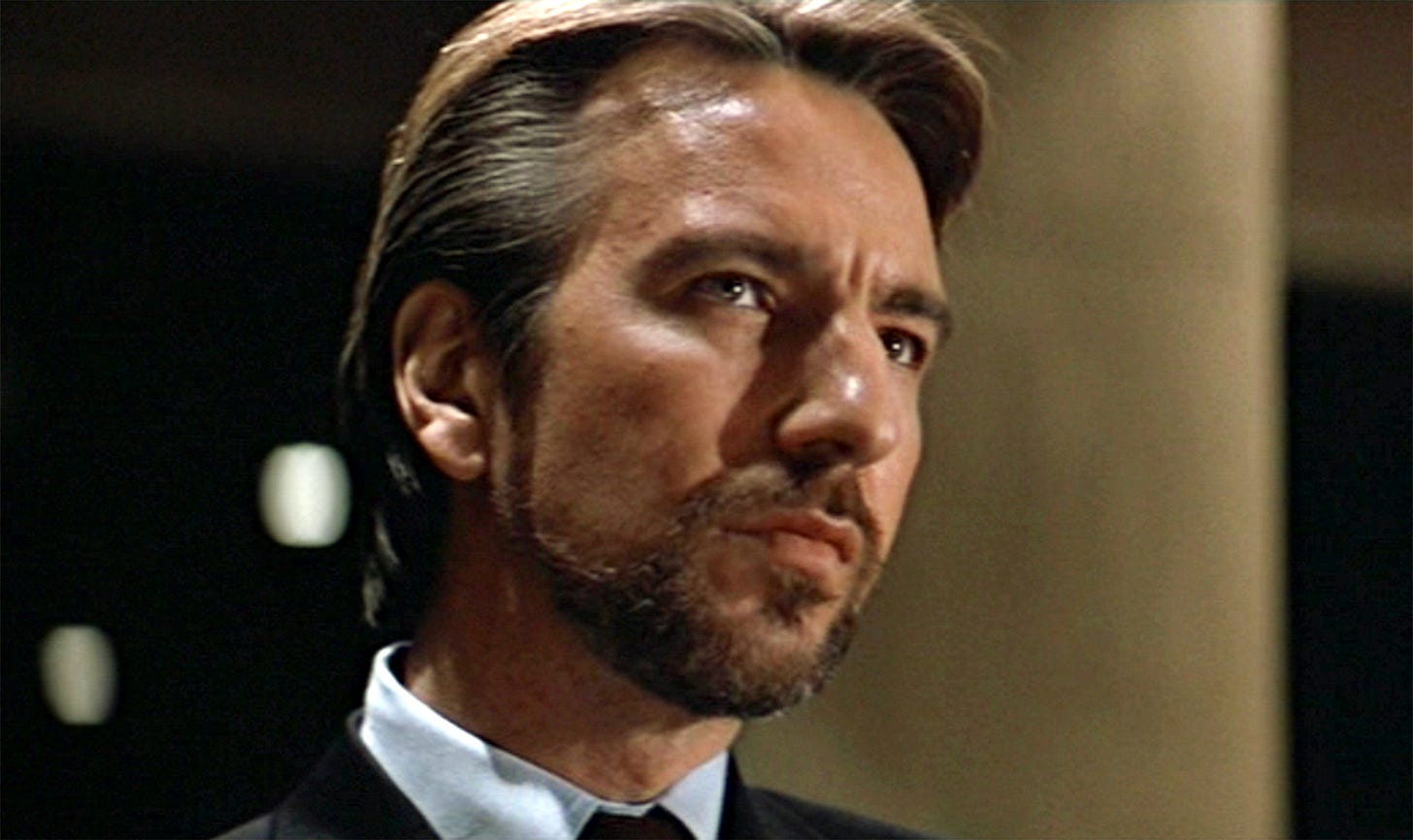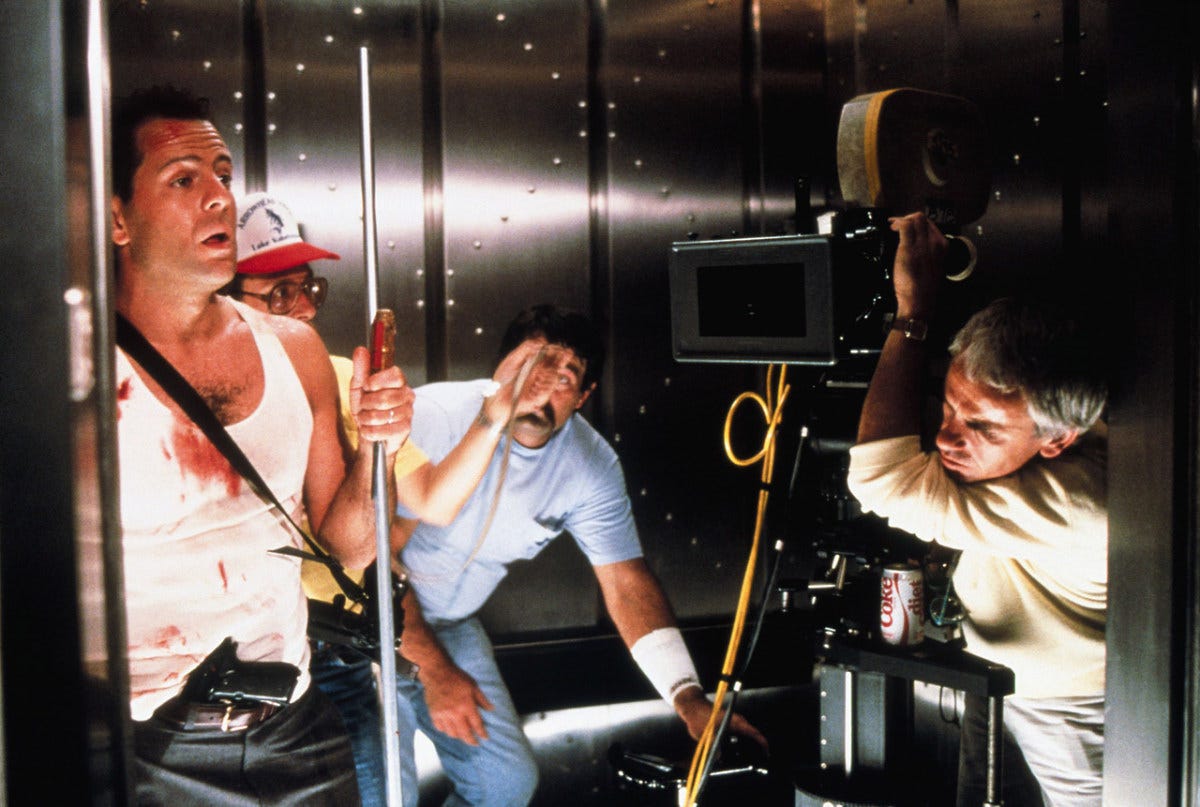“Die Hard”
1988 • 2hrs 12mins • R • Watch trailer
This year, Apple TV+ slapped another slice of A Christmas Carol onto the Dagwood sandwich of existing adaptations. Did we need another? No. But does Will Ferrell need a paycheck? Yes. Every big star has their window of bankability, and, ever since Elf, Ferrell’s is Christmas. But here’s a secret I’ve discovered: Hollywood’s been spiking the punch with a wicked pour of Scrooge for a long time. The archetypal grumpy leopard who may or may not change his spots has many forms. We’re drawing a five-year circle around ’88 to ’93 for a Scroogy Triple Header I’m calling Christmas for Jerks. Tonight we crawl through the ducting in part one with 1988’s Die Hard.
Here’s the plot. It’s Christmas Eve, and NYC cop John McClane (Bruce Willis) is in LA. His estranged wife, Holly (Bonnie Bedelia), is at an office Christmas party in Nakatomi Plaza, a skyscraper still under construction. Limo driver Argyle (De’voreaux White) chauffeurs McClane to the party where John hopes to win back Holly’s affection without any clear plan. While McClane is in the loo, terrorists led by German opportunist and future Snape, Hans Gruber (Alan Rickman), take over the building. Everyone but McClane is a hostage now—including Holly—but the bad guys don’t know about him yet. But what no one knows is that the terrorists are just thieves hoping to steal $640M in bonds during the confusion they’ve created. With only a pistol, a walkie talkie, a bag of C-4 and an overabundance of self-confidence in his arsenal, can McClane save Holly? And, amidst the action, can he find relationship-saving goodness in his heart? And can someone get this man a pair of Crocs?
How did we get Die Hard? It started as a book. Nothing Lasts Forever was published in 1979 and is the result of a novelist having a nightmare about being chased through a high-rise after watching The Towering Inferno. Too much buttered popcorn before bed. A lot of the novel made it to the film, including the Christmastime setting. Years later in ’87, screenwriter Jeb Stuart was hard up for cash. Between jobs, he worked on adapting the novel as a screenplay. His breakthrough came when, after a tired, stressed spat with his wife, he went for a drive. He hit a box in the road that turned out to be empty but could have meant a “die easy” for Stuart had it been full of something. He drove straight home and apologized for being a jerk to his wife. Then wrote 35 pages that very night about a man who wouldn’t be up a creek if he’d just said sorry before things went bad. I think the most interesting idea Stuart worked into his script was that McClane would become a better person but not a different person. This thread runs through the sequels that would follow.
Industry experts dismissed Die Hard. A guaranteed bomb, they said. But it wasn’t, and here’s five good reasons why:
First, Willis was no muscle-packed gym rat. He was trim and athletic, which helped sell all the scurrying around his character would need to do. Action movie fiends were used to the bulk of Schwarzenegger and Stallone. Willis was a fresh take.
Willis was also a TV actor not know for big screen work. But the thing about TV actors is they know how to deliver reliable, technical performances and they come with huge fanbases.
Next, though Die Hard hit theaters in mid-July, it was set at Christmas. The contrast against The Dead Pool, Red Heat, Crocodile Dundee II and Rambo III—all also released in July of ’88—probably helped set the underdog apart.
Fourth, it wasn’t shot or edited to be pretty. Cinematographer Jan de Bont pursued propulsive, engaging shots that served the story instead of highly planned works of art. They didn’t even storyboard most of the movie. The result is two hours that feel as tense and unplanned as what’s happening to the main characters.
And last, we can’t forget that the villain outshines the hero. Rickman was in his forties. He’d been a stage actor until now, mostly in the Royal Shakespeare Company. This was his first movie. His yuppie, droll, narcissistic baddie would be destined for the upper echelons along with Darth Vader and Hannibal Lecter.
We call Die Hard a classic now, but was it a hit then? Fox’s expectations were low. They hedged their bets by keeping the budget modest. Tri-Star spent two or three times as much on Rambo III. Early market research indicated people either didn’t care about Die Hard or hated it—more specifically, Willis. But preview audiences ate it up and spread the word. Limited initial release only created more demand. It would go on to be in the top five for ten straight weeks. It became the 10th best money-maker of ’88.
According to CinemaScore, audiences gave it an A+. But critics were mixed. Some liked Willis’s comedy chops, which contrasted nicely against the dying action hero model of the time. Have you heard Schwarzenegger try to tell a joke? Woof. But some felt he just wasn’t tough. They loved Rickman, whose character Caryn James called “the perfect snake” in her review for The New York Times. Critics didn’t like the violence, which Vincent Canby said was so loud and relentless it was suitable only for “kidults”. The Roman Catholic Church labeled it “morally objectionable”. Schwarzenegger saw it and liked it. It got four Oscar nominations. It was a home video hit, earning $36M in rentals alone by ’97.
It’s a very anti movie. Anti being defined by your job. Anti-big-biz. Anti-cops. Anti-politics. Anti-feminist. Anti-Germany, anti-Japan. Possibly even anti-buildings. But in spite of his being anti nearly everything and everyone, McClane only succeeds because of his alliances with Argyle and Powell. His single strength and weakness is improvising, which contrasts Gruber’s controlling nature. McClane reminds me of Danny Ocean, minus the self-awareness to see that he needs a whole team behind him.
Does our Scrooge of this movie have a change of heart? Perhaps not fully, though he’s been improved by a few degrees. Will it stick? That’s much harder to say.
Next week we go four years forward to ’92 for Tim Burton’s other Christmas movie, Batman Returns. It’s the yuletide flick for those who found the Batman of ’89 far too light-hearted.
NOTES:
In 2017, the Library of Congress deemed it “culturally significant” and inducted it into the National Film Registry.
Actors who almost were John McClane: Sylvester Stallone, Clint Eastwood, Harrison Ford, Mel Gibson, Al Pacino, and, of course, Arnold Schwarzenegger. He turned it down to make Twins.
Willis got a cool $5M for this ($12M in 2022 money), which was a lot. The president of Fox said it was because of his potential. Willis said it was because he was exactly what they needed. The chatter around Fox was that it was because everybody else turned them down and they had to start shooting soon.
McClane’s cowboy dialog was inspired by John Wayne characters. Except for his signature catchphrase, which is a lightly modified version of Roy Rogers’s “Yippee-ki-yay, kids”.
Willis acted for his show Moonlighting during the day, then for Die Hard at night. That may be responsible for his realistic grumpiness. And, yes: That means he was moonlighting in the moonlight while he was on Moonlighting.
If you need to shoot your film in a high-rise office, it’s handy to be 20th Century Fox and own Fox Plaza. An unoccupied office tower is hard to come by. Nearly the entire movie was shot in that building.
The matte painting we see out the window of the 30th floor set used animated lights and lighting tricks to seem as if it we were seeing moving traffic and time-of-day changes.
Nothing Lasts Forever was a sequel to the novel The Detective, which had been adapted as a Frank Sinatra picture. Because it was a sequel and they’d made the original, Fox was obligated by contract to offer the part of John McClane to Sinatra, who was 80 at the time. He said no thanks.
Die Hard was pitched as “Rambo in an office building”. After this, many future projects would be pitched as “Die Hard in…” One of these was Speed: “Die Hard on a bus”.










